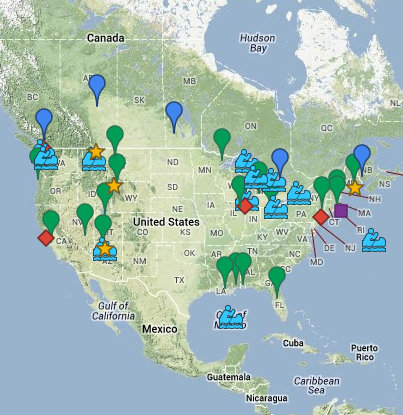A week and half ago, I got to spend two days at Fort Worden, a (very) little of which actually got spent on the beach. This is a familiar site (searching the blog for Fort Worden or Point Wilson turns up some related posts) and one I often use to illustrate how structures can impede littoral drift and how shorelines respond.
AERIAL VIEW
The Port Townsend Marine Science Center now occupies the end of the pier, but the structure itself has a long military history associated the Fort. At some point, planks were placed between the pier's pilings, most likely to reduce sedimentation in the small boat basin tucked in behind it. This resulted in a wide beach accumulating on the south side (sediment arrives from Port Townsend and the Chetzamoka Bluffs from this direction), and a substantial offset in the shoreline to the northeast (towards Point Wilson itself).
Every decade or so, people start wondering whether something can be done to alleviate some of the inconvenient geomorphic ramifications of the pier (and the associated boat basin and launch ramp). Trouble is, some things are hard to undo without creating other problems.
Wednesday, November 28, 2018
Port Gamble
There is a neat little beach hidden at the bottom of Teekalet Bluff in Port Gamble. People often stop to take in the view from the top, since it's a great place to monitor everything coming in and out of Hood Canal -- war canoes, sailing ships, nuclear submarines. But not so many people visit this little beach. I've known it was here for a long time, but this was the first time I'd actually checked it out.
AERIAL VIEW
When the northern shoreline of Port Gamble was developed, fill was extended out over the beach and protected with large rock (and other junk). This projection blocks the eastward drift and over time, a small wedge of beach has built out in front of the forested toe of the bluff.
I doubt there's much sediment being transported along this shoreline. It's at the end of a long littoral cell that begins farther south on Hood Canal, but I suspect the transport rates are higher where the southerly waves can act more effectively. Much of the sediment probably stalls out in the vicinity of Salsbury Point (a mile west of here), since there isn't much wave action to urge it along this north-facing shoreline (something similar happens between Point Elliott in Mukilteo and the Port of Everett, so I suppose this beach is a bit analogous to Pigeon Creek Beach), though none of this probably makes sense unless you look at the map).
It's possible that some of the sediment on this beach now makes itself around the riprap, but the fill extends into relatively deep water and I'd expect any excess material gets lost offshore. There is a small accidental beach tucked into the northwest side of the jetty a little farther east (bottom photo), but it doesn't show much evidence of continuing to accumulate sediment.
Here's another post from Port Gamble from a few years ago:
Teekalet: August 2014
AERIAL VIEW
I doubt there's much sediment being transported along this shoreline. It's at the end of a long littoral cell that begins farther south on Hood Canal, but I suspect the transport rates are higher where the southerly waves can act more effectively. Much of the sediment probably stalls out in the vicinity of Salsbury Point (a mile west of here), since there isn't much wave action to urge it along this north-facing shoreline (something similar happens between Point Elliott in Mukilteo and the Port of Everett, so I suppose this beach is a bit analogous to Pigeon Creek Beach), though none of this probably makes sense unless you look at the map).
It's possible that some of the sediment on this beach now makes itself around the riprap, but the fill extends into relatively deep water and I'd expect any excess material gets lost offshore. There is a small accidental beach tucked into the northwest side of the jetty a little farther east (bottom photo), but it doesn't show much evidence of continuing to accumulate sediment.
Here's another post from Port Gamble from a few years ago:
Teekalet: August 2014
Labels:
kitsap,
puget sound,
salish sea,
washington
Subscribe to:
Posts (Atom)








